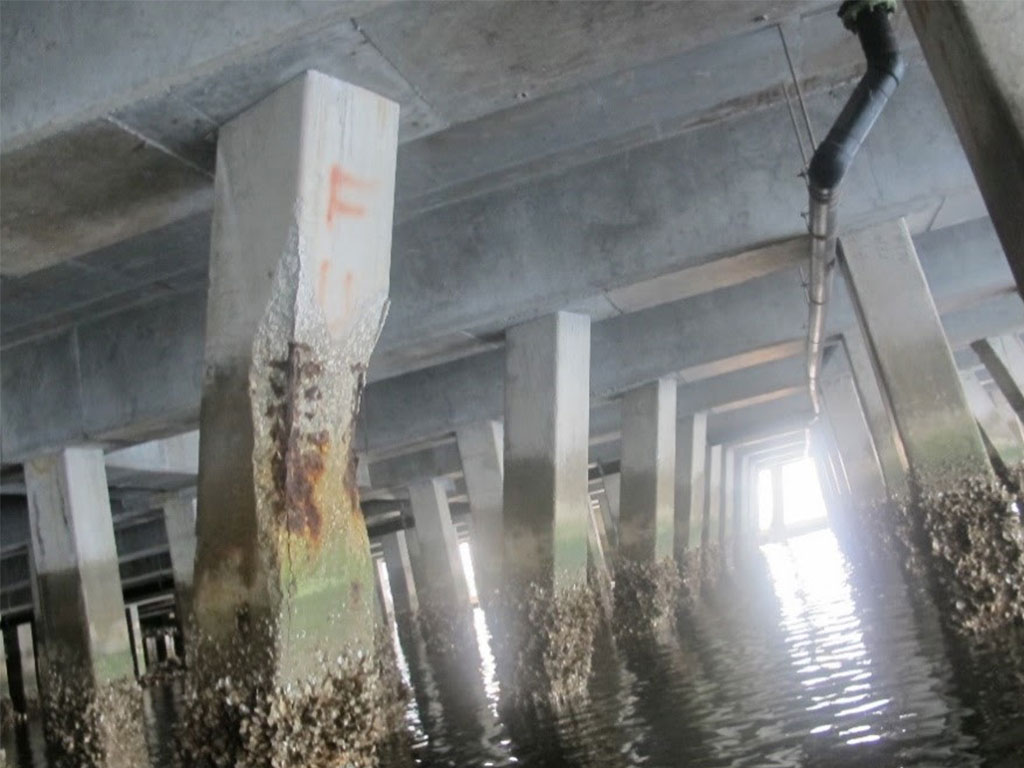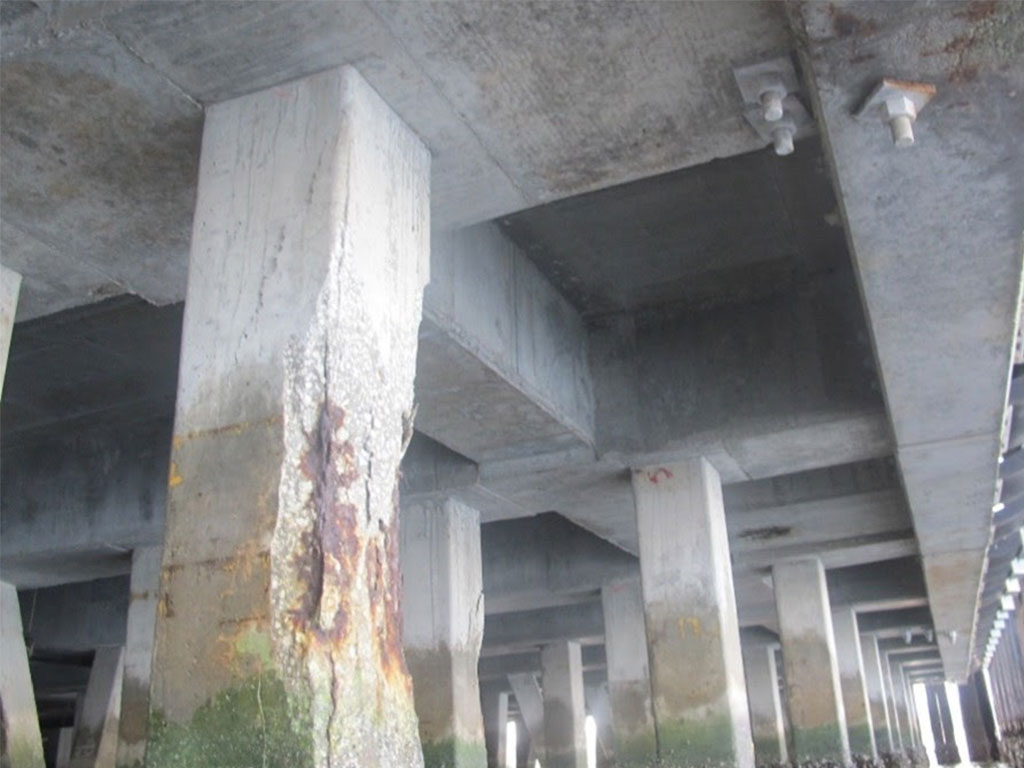By George Sanford, P.E. or Warren Forensics
Scenario: The owners of Jones’ Marine, a marina with a wharf structure on a tidal saltwater river, cater to the operators of ships, barges, and large yachts. There are both diesel and gasoline fuel pumps at the edge of the wharf. In addition, a large mobile crane for lifting the large vessels out of the water for maintenance is in service at the wharf. This crane is driven out to the edge of the wharf deck suspended over the water, subjecting this deck and the structure beneath it to very high loading. They purchased the property from its former owners about (10)-years ago and are conscientious about the maintenance and upkeep of their thriving facility. They decide it is time to have a survey performed on the condition of the precast reinforced concrete piles and pile caps beneath and supporting the concrete wharf platform/deck. They are alarmed at what is discovered by this survey: Significant spalling of the piles and pile caps due to corrosion of the internal reinforcing steel bars is widespread. Due to the high loading, these components are subjected to, and the severity of the damage, the Surveyor recommends repair or replacement of these structural members immediately, as failure is a distinct possibility. To do this basically means that the wharf will have to shut down most or all of its operations and be partially rebuilt. Needless to say, the ownership team is quite perplexed by this dilemma, as it will result in significant loss of income and high repair costs. Meanwhile, the bills for the mortgage, the utilities, and all the other expenses will continue to roll in.
As demonstrated in this scenario, moisture intrusion into structural reinforced concrete can create major problems. In previous blogs, I discussed issues with moisture intrusion into floor slabs-on-grade, and how to mitigate the problems it causes. In this blog, I will address various structural reinforced concrete members. These include Structural slabs-on-grade, footings/grade beams, piles, piers, pile caps, suspended beams, walls, and columns. Most of these members are suspended, so there are no concerns with soil contact, with the exception of slabs-on-grade, footings/grade beams, and the portions of precast piles which are driven below grade. Structural slabs-on-grade are typically greater than 6” thick, and are reinforced with one, two, or even more layers of rebar. Some structural slabs are “monolithic”. These are floor slabs with the footings and grade beams poured together monolithically, or integral to each other. All of these elements contain rebar, which being unfinished mild carbon steel, is highly susceptible to corrosion as a result of exposure to moisture which can migrate through unblemished, bare, uncoated concrete material, or into hairline or larger cracks. It is interesting to note that “weathering” of the rebar, which produces a thin layer of rusting (not flaky rusting), is considered desirable prior to installation, as this oxidation knocks down the layer of mill scale, grease, or oil which rebar typically has on its surface when shipped from the manufacturer. The reason for this is that the oxidation effect actually promotes the bond, i.e., purchase, or “development”, of the deformed rebar into the cured concrete material. However, corrosion of the rebar once the structural member is in-service is problematic, as it leads to swelling of the rusted, iron oxide-covered bars, causing spalling or breakage of the surrounding concrete, thereby weakening the member. This may result in localized buckling or rupture, or even catastrophic failure or collapse. Obviously, such mishaps have the likelihood of completely shutting down the affected operation and being very expensive to repair.


The photographs depicted herein show severe examples of corroded bars and spalling of concrete. These are pictures of the precast piles and pile caps/suspended beams of a wharf structure over tidal saltwater, which is very high in chlorides. The tide cycling leading to wetting and drying of the concrete and steel bars at least twice daily promotes the rapid and excessive corrosion of these bars. Notably, the portions of the precast piles which remain submerged throughout the tide cycle would not be as susceptible to this level of corrosion. These components would not be exposed to air, but the oxidation/rusting would most likely still occur, albeit more gradually.
To mitigate the issue of rebar corrosion due to moisture exposure, there are a number of specialized rebar products commercially available. These include epoxy-coated and galvanized steel bars. Fiberglass bars are also available, which obviously would not rust, but are less forgiving under bending and shear loading than steel. For a technical specification for avoiding cracking of the concrete, refer to ACI 224R-01: “Control of Cracking in Concrete Structures”.
As is apparent the intrusion of moisture into slabs and structural reinforced concrete is an undesirable nuisance at best, and catastrophic at worst. However, reinforced concrete is a very strong and versatile material and a staple of modern construction. Therefore, the installers and end-users of these concrete products should take whatever means necessary to avoid moisture exposure and the subsequent problems it causes.
If you would like more information about this subject, please contact George Sanford, PE, at (803) 732-6600 or through their website at WarrenForensics.com.
This is a publication of Southern Loss Association, Inc., P.O. Box 421564, Atlanta, GA 30342. The articles published on this website are in a general format and are not intended to be legal advice applicable to any specific circumstances. Legal opinions may vary when based on subtle factual differences. All rights reserved.
